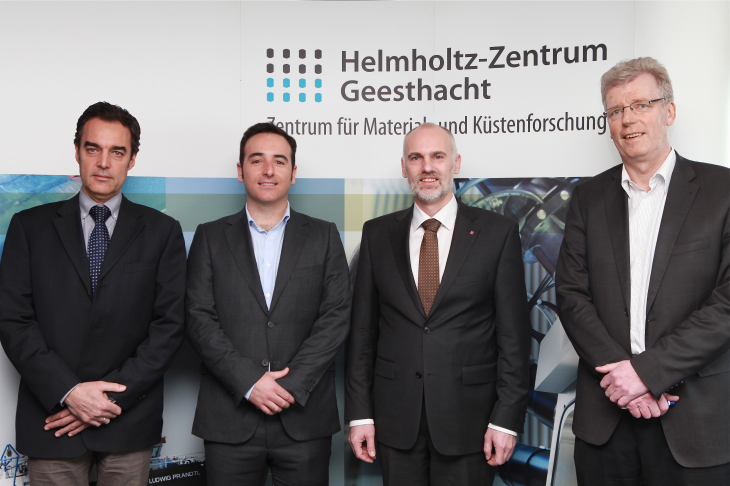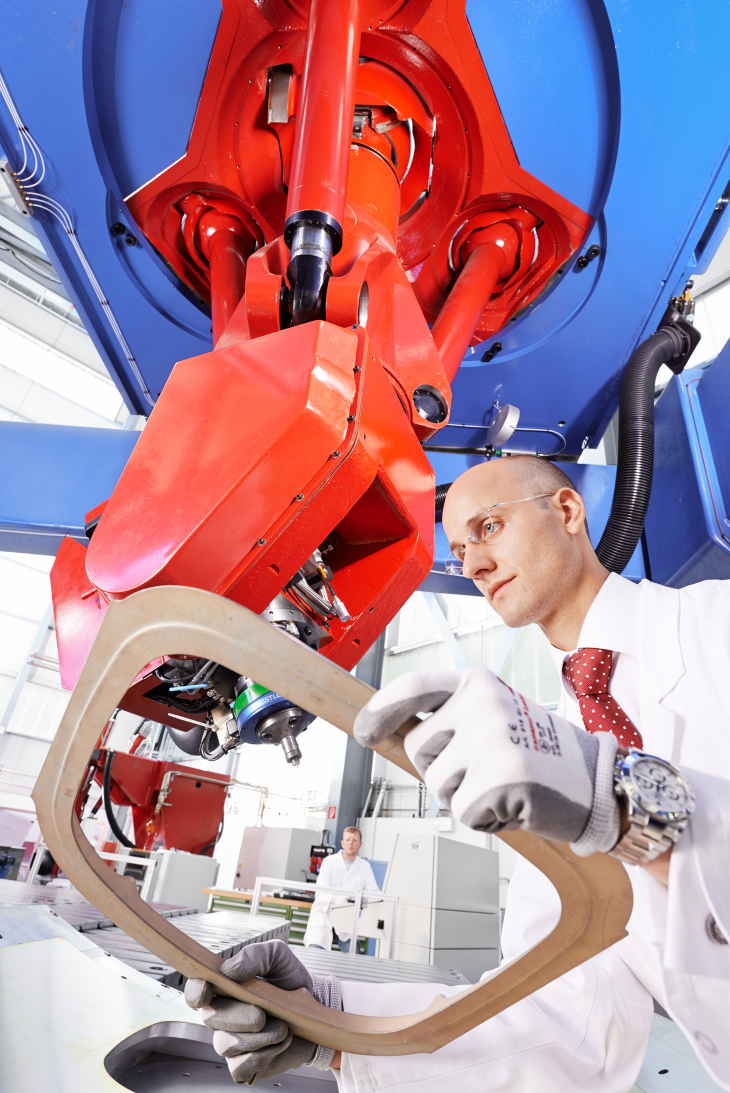New licensee adopts “Made in Geesthacht” technology
The department of “Solid State Joining Processes” at the Helmholtz-Zentrum Geesthacht (HZG) has recently concluded a new cooperation agreement with the Spanish machine construction specialists, Loxin. Patented joining technologies, developed by Geesthacht materials research scientists, will thus be integrated into a wide range of technological applications throughout the world.

They concluded a new cooperation agreement : Juan Ramón López-Gil (Director Loxin, CEO), Enrique Cristobalena (Sales Director Loxin), Norbert Huber (HZG-Director), Kay Bern (HZG-Authorized Officer) left to right. Photo: HZG/ Torsten Fischer
Under the direction of Dr. Jorge dos Santos, the materials research scientists have demonstrated a great deal of inventive talent in the field of joining technologies over the past 15 years and have been granted twelve patents within this period of time.
Their research and the resulting patents are focussed on friction based joining technologies. Depending on the respective application, a wide variety of materials can thus be welded to each other e.g. aluminium with steel or fibre-reinforced polymers with metals. A licensee cooperation agreement, covering all twelve patents, has now been reached with the machine construction specialist Loxin, which operates worldwide from its headquarters in Esquiroz, Spain.
As Prof. Dr. Norbert Huber, director of the HZG Institute of Materials Research, explains: “In the modern-day construction of aircraft and automobiles, lightweight materials such as aluminium, magnesium and titanium alloys and also plastics and composite materials are being increasingly combined with each other in hybrid structures. Nowadays these structures are generally riveted or bonded with adhesives.
However, each rivet means that there is additional weight and adhesive bonding is, in most cases, very time consuming and involves higher costs.

The department has been working on friction welding based processes since the beginning of the nineties. Photo: HZG/ Christian Schmid
Therefore, the development of fundamentally new joining technologies is playing a vital role, in order to create, for example, lighter, damage-tolerant aircraft constructions and crash-proof vehicle components for environmentally-friendly mobility. This new cooperation thus offers the licensee Loxin a great deal of potential.
In future, the company will be able to offer its joining technology installations together with integrated solid state joining technologies from Geesthacht. These patented joining technologies present obvious advantages: no additional welding materials are used, a costly preparation of the surface is no longer necessary and the joining processes are very environmentally friendly with regard to energy consumption and emissions.
This leads to an overall higher level of productivity, when compared to conventional joining technologies. The danger of crack formation in the welding seam is also reduced, as the materials are welded in the solid phase without melting, avoiding the formation of pores. Components manufactured in this way are lighter and safer – a significant advance over the conventional techniques in use today.
The headquarters of the machine construction specialist Loxin are located near Pamplona in Spain. The company develops and sells its machines and installations globally. Therefore, with the help of the Helmholtz-Zentrum Geesthacht patented and award-winning joining technologies, high performance materials will be manufactured worldwide, both swiftly and efficiently, in an environmentally friendly manner.
The Department of Solid State Joining Processes
The department, under the direction of Dr. Jorge dos Santos, has been working on friction welding based processes since the beginning of the nineties; initially with titanium and steel materials. Since 1996, the scientists have been carrying out research on the Friction Stir Welding Process (FSW). In 1999 patent applications were made for Friction Stir Spot Welding (FSSW) and Friction Spot Welding (FSP). Further processes have been added over the last few years: Hybrid Friction-Diffusion Bonding (HFDB), FricRiveting und Injection Clinching Joining (ICJ). In the case of FSW and related processes, it is predominantly aluminium and magnesium alloys which are joined. In the FricRiveting and ICJ processes, polymers are joined with metals, for example.
Contact

Helmholtz-Zentrum Geesthacht - Zentrum für Material- und Küstenforschung
Phone: +49 (0)4152 87-1648
E-mail contactMax-Planck-Straße 1
21502 Geesthacht
